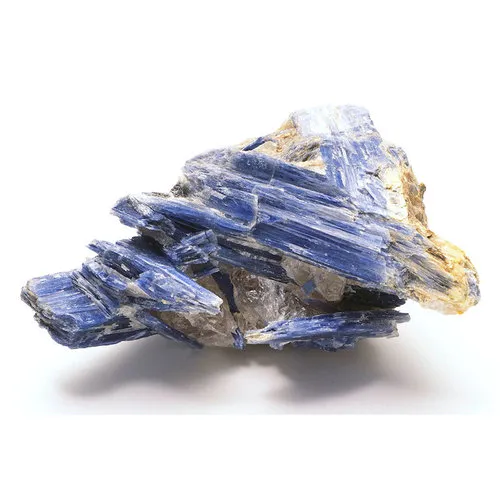
Appearance
The name kyanite is derived from the Greek word “kuanos,” which means blue, reflecting its most frequent blue coloring. Kyanite usually forms bladed crystals. Kyanite frequently crystallizes as long, bladed crystals. These crystals have a hardness of 4.5 to 5 along their length and 6.5 to 7 across their width. This mineral comes in blue, white, gray, green, and colorless variations.
Geographical Distribution
Although kyanite is found all over the world, major deposits can be found in a few nations. The United States, Brazil, Nepal, India, Switzerland, Australia, and Myanmar are a few prominent locations for kyanite extraction and distribution (Burma).
Metaphysical Properties
Some people think that kyanite has mystical qualities that help with chakra alignment, energy work, and meditation. It is believed to encourage healing, self-expression, and communication.

Chemical Composition
Kyanite is a member of the aluminosilicate mineral family and consists mostly of aluminum silicate. Al2SiO5 is its chemical formula.
Types
The following are a few notable kyanite varieties:
Blue Kyanite:
The most popular type, blue kyanite, is valued for its vivid blue hue. Its metaphysical qualities are thought to foster psychic talents, self-expression, and communication. It is frequently used in jewelry. The throat and third-eye chakras are supposed to be aligned and cleared by blue kyanite.
Green Kyanite:
The hue of green or bluish-green kyanite is well-known. It’s thought to improve one’s relationship with the natural world. Green kyanite is thought to promote growth, balance, and healing. It is connected to the heart chakra.
Black Kyanite:
Dark hues that range from black to deep gray define black kyanite. It is thought to have protective and grounding qualities that facilitate people’s connection to Earth’s energy. In energy work and meditation, black kyanite is frequently utilized to remove blocks and negative energy.
Orange Kyanite:
Orange kyanite is thought to boost self-esteem, sociability, and creativity. It is connected to the sacral chakra. It is believed to give the person a feeling of warmth and energy. Pale orange to reddish-orange is possible for the hue.
Auralite-23:
Auralite-23 is a rare variety of kyanite that is distinguished by its special blend of over 23 distinct minerals, including amethyst, kyanite, and other crystals. It is thought to have potent metaphysical qualities that foster healing, insight, and spiritual development. Auralite-23 is frequently employed in energy work and meditation.
Uses
- Refractory Materials: The main application for kyanite is as a raw material for high-temperature refractory materials. The material’s high melting point and resilience to heat shock render it perfect for producing castables, refractory bricks, and other items utilized in high-temperature settings like kilns and furnaces, as well as glass making facilities.
- Foundry Industry: In the foundry sector, kyanite is a component utilized in the creation of foundry molds. It aids in the production of molds resistant to the extreme heat and thermal cycling experienced during metal casting.
- Glass Manufacturing: To improve the quality and longevity of high-temperature glass goods, like laboratory glassware and fiberglass, kyanite is added to glass compositions. It enhances glass’s ability to withstand heat stress.
- Ceramics: Ceramics, especially porcelain and fine china, are made with the usage of kyanite. These products become stronger and more resistant to heat as a result, making them suitable for high-temperature firing procedures.
- Metallurgical Industry: In the metallurgical sector, kyanite can be used as a refractory material to line crucibles and furnaces used for the smelting and refining of metals, such as non-ferrous metals, steel, and aluminum.
- Jewelry: Blue kyanite is sometimes used in jewelry as cabochons, faceted gemstones, and ornamental beads because of its eye-catching blue color and distinctive crystal habit. However, because of its comparatively low hardness, it is not as frequently used in jewelry as other gemstones.
Table





